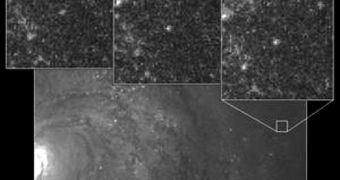Recent observations conducted on V 19, a variable star (Cepheid) in the nearby spiral galaxy Messier 33, shows that the object is no longer exhibiting the pulsating behavior that this call of stars is known for. It would appear that the object stopped doing so sometime in the past few decades.
Famed astronomer Edwin Hubble first discovered a Cepheid variable in galaxy M31, and managed a tremendous breakthrough in the process. Until those observations, scientists believed that the patch agglomerations of stars and dust they saw in the night sky were parts of the Milky Way.
What Hubble showed was that, in fact, three spiral nebulae were “island Universes” in themselves. We now call such structures galaxies. This tremendous discovery was made possible by the Period-Luminosity relationship, which the astronomer applied on the Cepheid variable he found in M31.
Later on, he and other astronomers looked at spiral galaxy M33, and identified no less than 35 Cepheid stars, including one called V 19. The object's period was 54.7 days, and it boasted an amplitude of 1.1 magnitudes, Universe Today reports.
In the new study, which was presented a few days ago in Seattle, at the 217th winter meeting of the American Astronomical Society (AAS 2011), experts show that the star is no longer pulsating at the specified interval. This means that it stopped behaving as a Cepheid variable.
The investigation was conducted by a large collaboration of universities and research institutions, that used the National Optical Astronomy Observatory (NOAO), the 3.5-meter Wisconsin Observatory, and the1.3-meter Robotically-Controlled Telescope (RCT) for the study.
Astronomers decided to conduct the study to verify the conclusions of a 2001 study which showed at the time that V 19 exhibited a massive decrease in brightness amplitude. The authors of the report showed the amplitude was at less than 10% of the magnitude reported by Hubble in 1926.
In fact, it could be that the variations were even more considerable, but that they were not picked up by the instruments used in the 2001 study. The detectors may have been incapable of picking up those faint signals.
The team that conducted the new study says that the variations in V 19's brightness may be below 0.1 magnitudes, a considerable drop from 1.1 magnitudes. The existing variations barely exceed the background noise of the observations the team conducted.
At this point, existing theories cannot explain why these changes occur. A similar event was recorded on a star called Polaris as well, and astronomers have been trying to explain why for some time. The fact that they happened on V 19 shows that this is a common occurrence.
The only way to figure out what is happening is to closely monitor these stars for extended periods of time, in order to see whether other effects than the known ones are at work in determining their brightness and pulsation.

 14 DAY TRIAL //
14 DAY TRIAL //